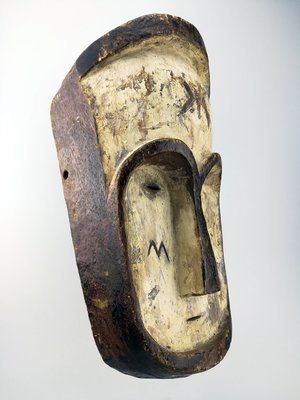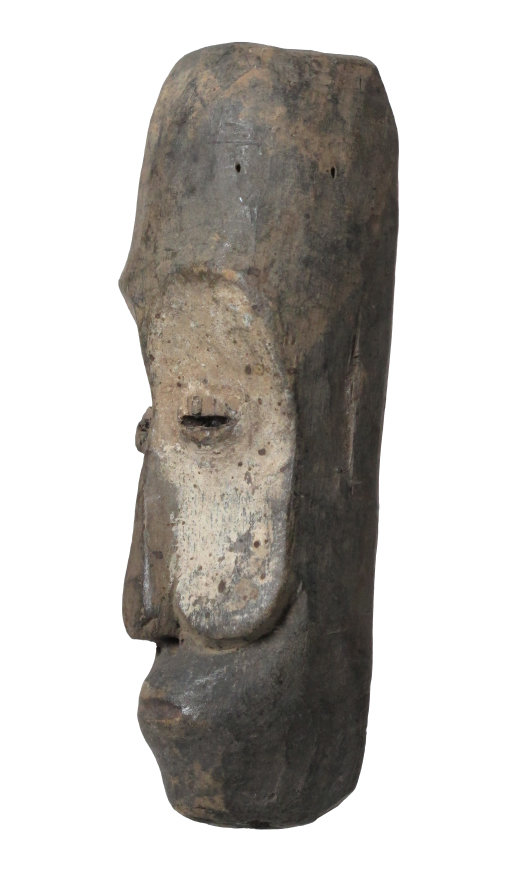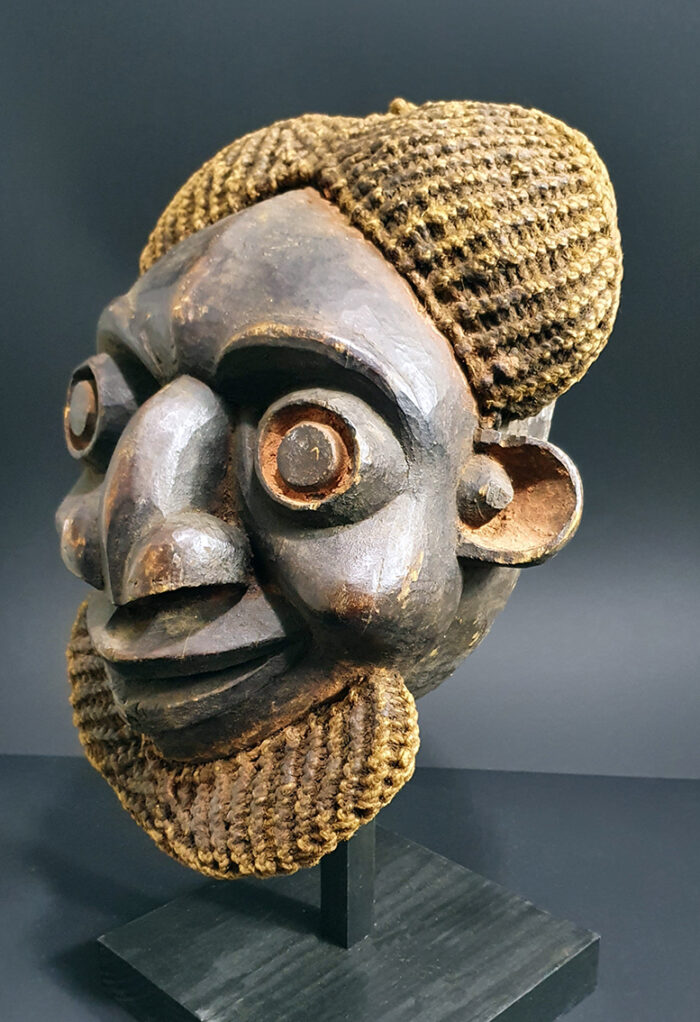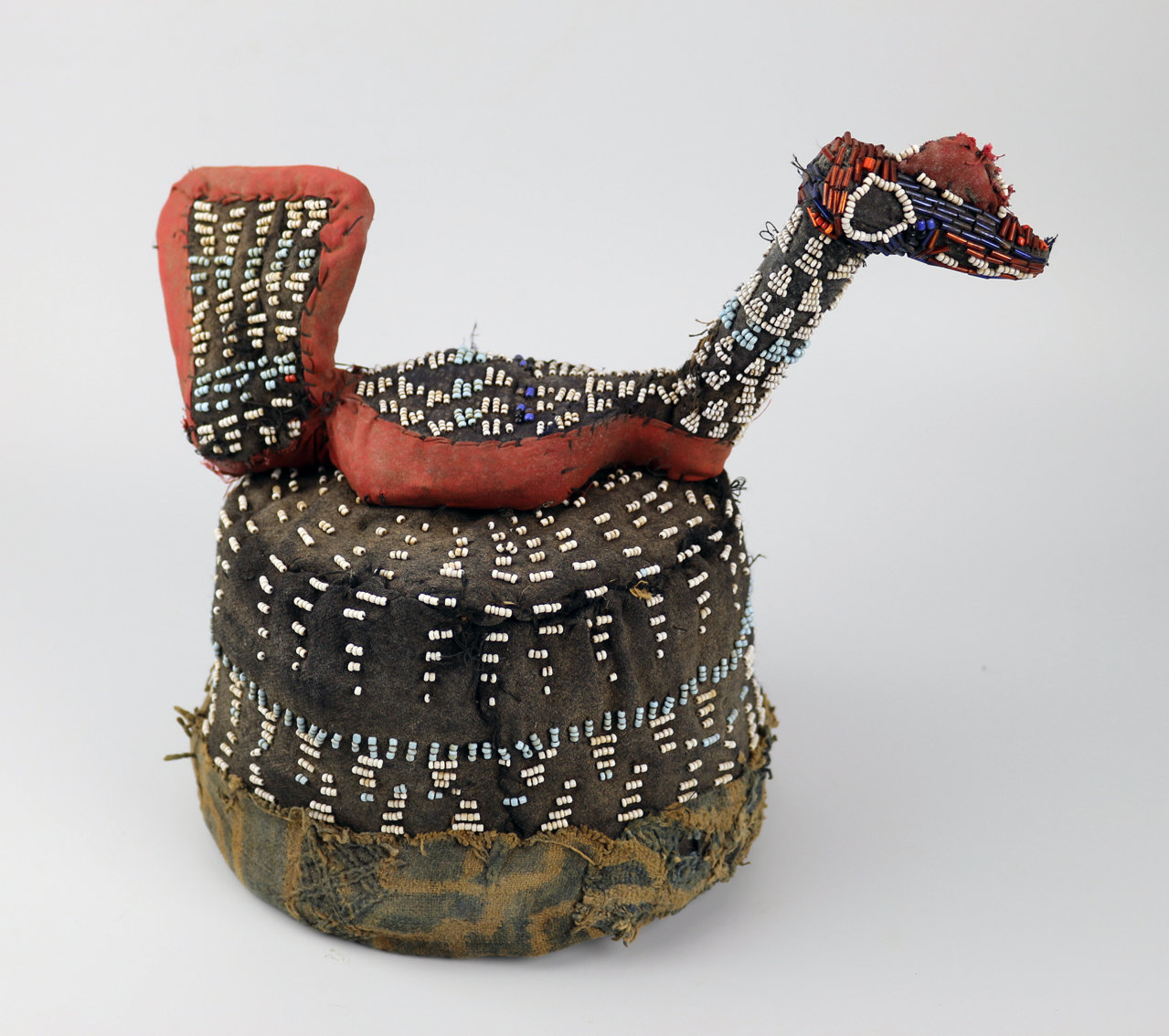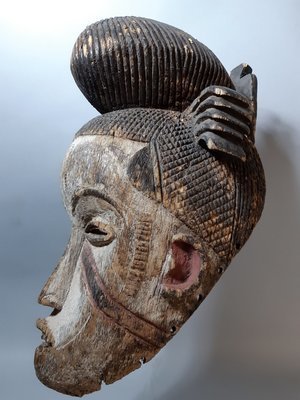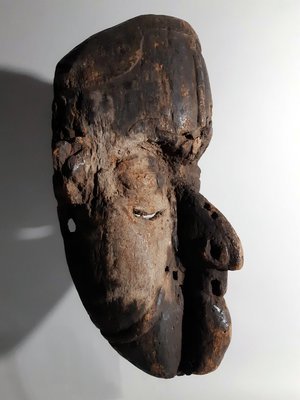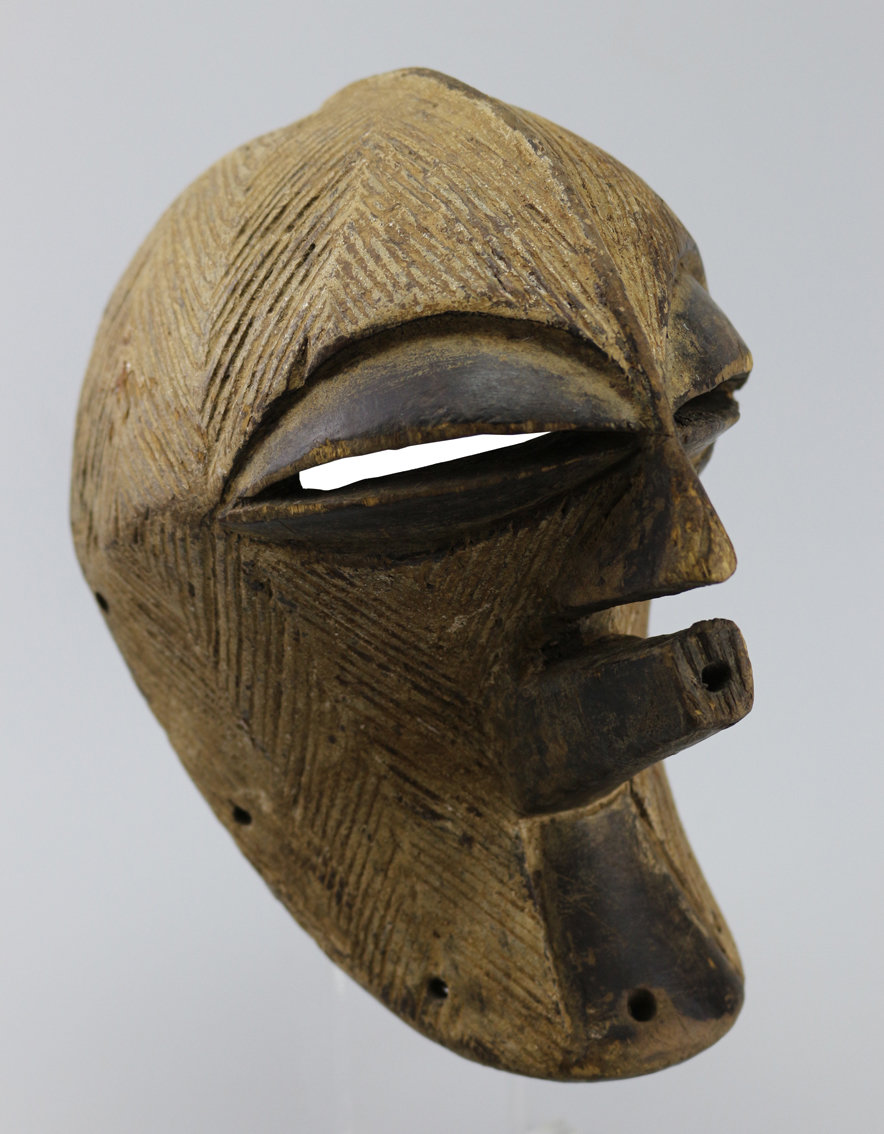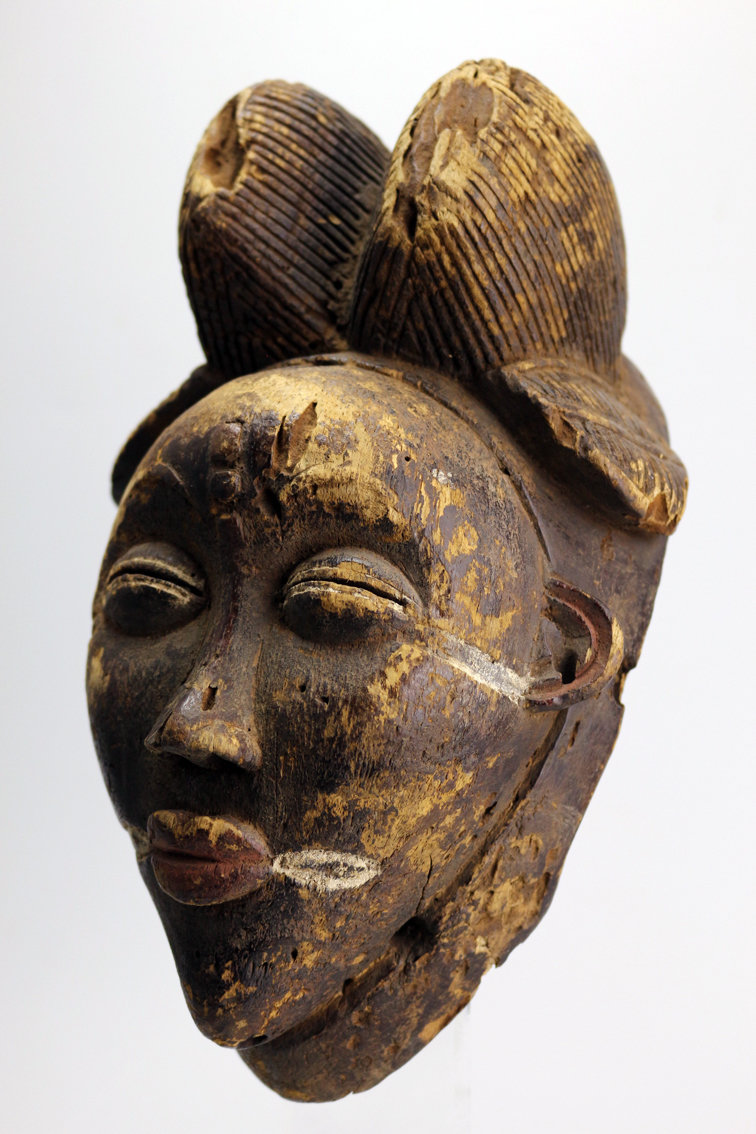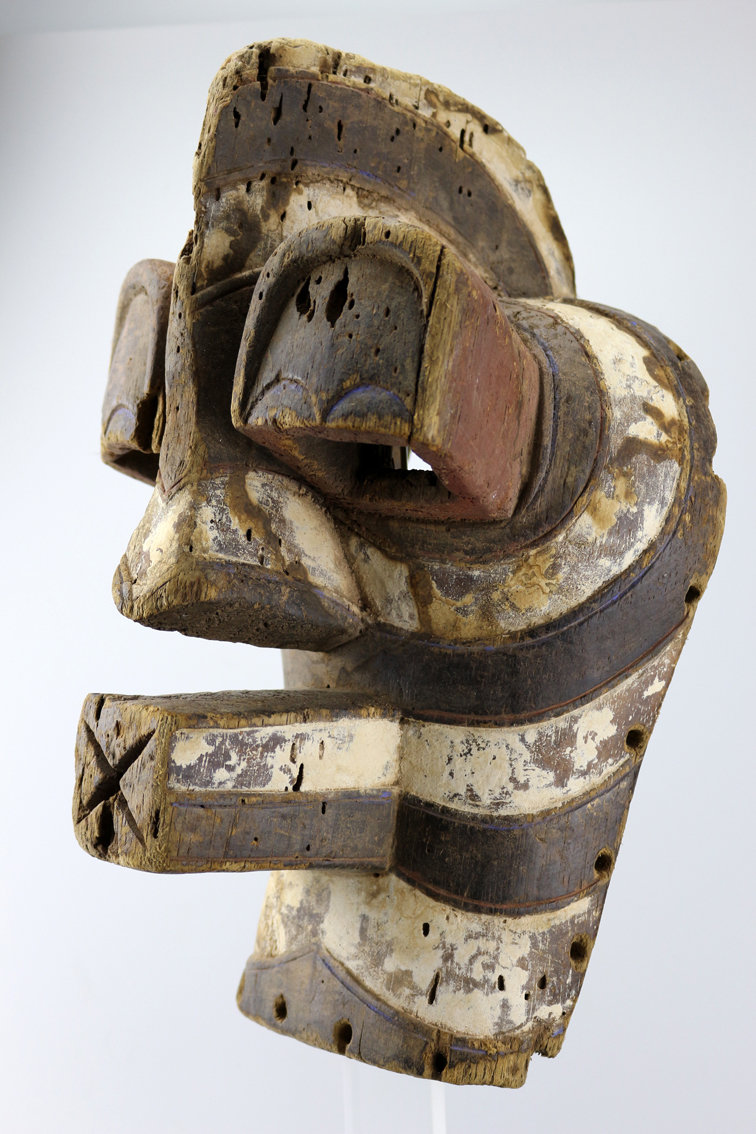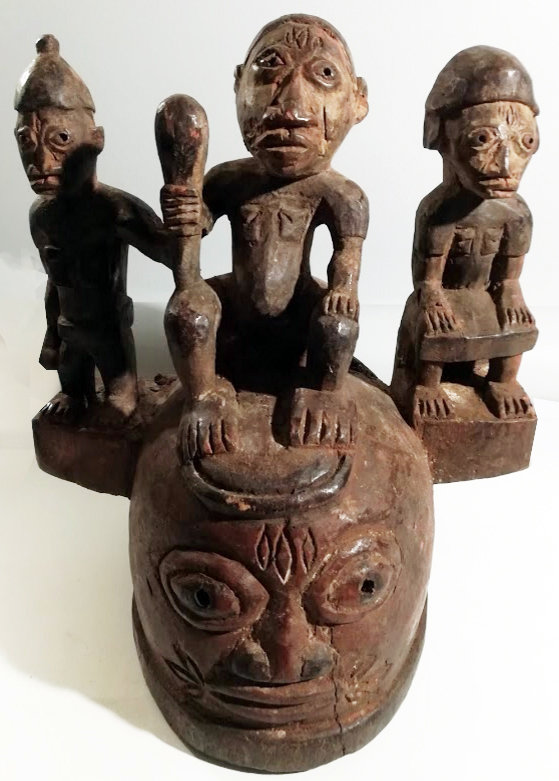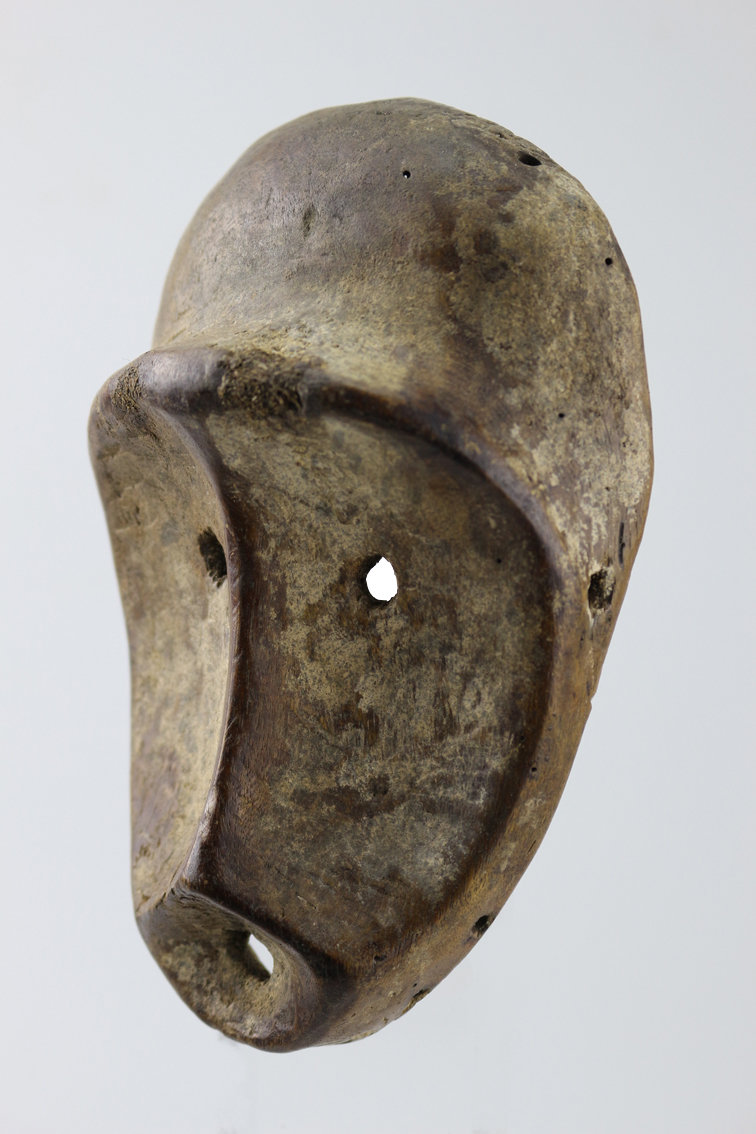-
Vue Rapide€2.900,00
Fang mask, N’Gil. Fang Gonta mask.
(Bitam Village / Owem Province)
This mask comes from an old fang tradition.
The “Ngil” was a company (in the group sense) of a judicial nature. Its purpose was the search and the setting out of state to harm beyem sorcerers charged with an evil spirit.
The initiation to “Ngil” included:
a prior physical and moral purification;
flogging;
a confession of crimes and / or breaches of prohibitions;
an ordinal test;
a presentation of the relics of the ancestors (byeri);
sacrifices.It was a symbolic passage from the androgynous state to the adult, sexually defined state. The sacred place of “Ngil” was a rectangular clearing of bush called ésam, with large recesses of wet earth of vaguely human form representing “Ngil” and his wife.
The neophytes had to crawl in front of these effigies by passing over a pit in which were hidden warriors seeking to wound them with their weapons. They also had to undergo the ant test. Only men could be introduced to “Ngil”. The “Ngil” was basically used to protect the individual against evil and poisoning. It was part of the rituals of regulation of traditional Gabonese village life.
The ritual continued in the village courtyard in the early morning or at dusk. Armed with a ritual saber or a simple club, the “Ngil” was supposed to destroy the huts of villagers in conflict with other members of society. These discussions focused on adultery, theft or debts. The mask wearer had a deep voice that frightened women and children.
***
Fang mask, N’Gil. Bitam Village / Owem Province. Fang Gonta mask.
This mask comes from an ancient fang tradition.
The “Ngil” was a society (in the sense of group) of a judicial nature. His goal was to search and incapacitate beyem sorcerers charged with an evil spirit.
The initiation to “Ngil” included:
a prior physical and moral purification;
flogging;
a confession of crimes and / or breaks of prohibitions;
ordalic ordeal;
a presentation of the relics of the ancestors (byeri);
sacrifices.It was a symbolic passage, from the androgynous state to the adult, sexually defined state. The sacred place of the “Ngil” was a bush clearing, rectangular in shape, called esam, with large recumbent mounds of vaguely human wet form representing “Ngil” and his wife.
The neophytes had to crawl before these effigies by passing over a pit in which were hidden warriors trying to hurt them with their weapons. They also had to be tested by ants. Only men could be initiated into “Ngil”. The “Ngil” was in fact used as protection of the individual against evil spells and poisonings. It was part of the regulatory rituals of traditional Gabonese village life.
The ritual continued in the village courtyard early in the morning or at dusk. Armed with a ritual sword or a simple club, the “Ngil” was supposed to destroy the huts of villagers in conflict with other members of society. These palavers were about adultery, robbery or debt. The wearer of the mask had a deep voice that frightened women and children.
***
Fang Maske, N’Gil. Bitam-Dorf / Owem-Provinz. Fang Gonta Maske.
Diese Maske stammt aus einer alten Fangtradition.
Das “Ngil” war eine Gesellschaft (im Sinne einer Gruppe) juristischer Natur. Sein Ziel war es, Zauberer zu finden, die mit einem bösen Geist aufgeladen waren.
Die Einweihung zu “Ngil” beinhaltete:
eine vorherige körperliche und moralische Reinigung;
Auspeitschen;
ein Geständnis von Verbrechen und / oder Pausen von Verboten;
Ordalische Tortur;
eine Präsentation der Reliquien der Vorfahren (byeri);
Opfergaben.Es war eine symbolische Passage, vom androgynen Zustand zum erwachsenen, sexuell definierten Zustand. Der heilige Ort des “Ngil” war eine rechteckige, rechteckige Buschlichtung, genannt Esam, mit großen, liegenden, menschenähnlichen Nischen, die “Ngil” und seine Frau darstellen.
Die Neophyten mussten vor diesen Abbildern durch eine Grube klettern, in der sich versteckte Krieger befanden, die versuchten, sie mit ihren Waffen zu verletzen. Sie mussten auch von Ameisen getestet werden. Nur Männer konnten in “Ngil” eingeweiht werden. Das “Ngil” wurde tatsächlich als Schutz des Individuums vor bösen Zaubersprüchen und Vergiftungen verwendet. Es war Teil der regulatorischen Rituale des traditionellen Gabuner Dorflebens.
Das Ritual ging frühmorgens oder in der Abenddämmerung im Hof des Dorfes weiter. Mit einem rituellen Schwert oder einem einfachen Club bewaffnet sollte der “Ngil” die Hütten der Dorfbewohner zerstören, die sich im Konflikt mit anderen Mitgliedern der Gesellschaft befanden. Diese Palaver waren über Ehebruch, Raub oder Schulden. Der Träger der Maske hatte eine tiefe Stimme, die Frauen und Kinder erschreckte.
-
Vue Rapide€650,00
Gabon, Kwélé mask
The Kwele (or Bakwele normally in the plural) are a people of Central Africa, established in the northwest of the Republic of Congo, on the border with Gabon, between the Dja river and the Ivindo. A few also live in southern Cameroon. They are related to the group of Kotas. The Kwele are renowned for their mask art.
Les Kwele ne produisent presque pas de statues, principalement des masques3, également des plaques sculptées que l’on trouve à l’intérieur des cases et des soufflets de forge au manche sculpté d’une figurine4. Leurs masques sont généralement plats, avec un visage blanc en forme de cœur, des yeux incisés et un nez triangulaire5. On les appelle ekuk. Peu portés au cours des cérémonies d’initiation du culte des bwété, ils étaient accrochés dans les maisons pour attirer les forces bénéfiques5. Les masques anthropomorphes sont désignés sous le nom de pibibuzé, ce qui signifie « homme ». On trouve également des masques zoomorphes(antilope, gorille).
***
Gabon, Kwele mask
The Kwele (or Bakwele normally plural) are a people of Central Africa, established in the north-west of the Republic of Congo, on the border with Gabon, between the river Dja and Ivindo. Some also live in southern Cameroon. They are related to the Kota group. The Kwele are famous for their mask art.
The Kwele do not produce almost statues, mainly masks3, also carved plates found inside the huts and bellows forge with the carved handle of a figurine4. Their masks are usually flat, with a white heart-shaped face, incised eyes and a triangular nose5. They are called ekuk. Little worn during initiation ceremonies of worship, they were hung in houses to attract beneficial forces. Anthropomorphic masks are referred to as pibibuze, which means “man”. There are also zoomorphic masks (antelope, gorilla).
***
Gabun, Kwele Maske
Die Kwele (oder Bakwele normalerweise Plural) sind ein Volk von Zentralafrika, im Nordwesten der Republik Kongo, an der Grenze zu Gabun, zwischen dem Fluss Dja und Ivindo. Einige leben auch im südlichen Kamerun. Sie sind mit der Kota-Gruppe verwandt. Die Kwele sind berühmt für ihre Maskenkunst.
Die Kwele produzieren fast keine Statuen, hauptsächlich Masken3, auch geschnitzte Platten, die in den Hütten gefunden wurden, und Balgschmieden mit dem geschnitzten Griff einer Figur4. Ihre Masken sind normalerweise flach, mit einem weißen herzförmigen Gesicht, eingeschnittenen Augen und einer dreieckigen Nase5. Sie heißen Ekuk. Während der Initiationszeremonien wurden sie wenig getragen und in Häusern aufgehängt, um wohltätige Kräfte anzuziehen. Anthropomorphic Masken werden als Pibibuze bezeichnet, was “Mensch” bedeutet. Es gibt auch zoomorphhe Masken (Antelope, Gorilla).
-
Vue Rapide
Important masque de danse Bamiléké (Cameroun)
Les traits sont ici particulièrement expressifs avec un sourire profondément énigmatique.
Le menton et la coiffe sont recouverts d’une structure de cordes finements tressées et habilement maintenues à plat.
Le travail de l’artiste sculpteur est ici particulièrement remarquable en raison du relief extrêmement prononcé et proéminent de chacune des parties du visage : arrête du front, arcades sourcillères, yeux, nez, bouche, menton, oreille et coiffe.
Ce type de masque était amené à “sortir” pour rythmer les différents rituels de la vie de la communauté : naissance, mariage, célébration, disparition d’un notable, etc.
Dimensions : 38 x 29 x 17CM.
Provenance : ancienne collection française.
Belle patine d’usage de l’ensemble. Matériaux : Bois, cordelettes.
Livré avec son socle. (Afrique, Art africain, Civilisation et ethnies -401afr)
Remise d’un certificat.
Envoi soigné et sécurisé partout dans le monde.
-
Vue Rapide€2.100,00
Bamileke pearl mask, Cameroon
The Bamileke are a people of Central Africa, coming from Cameroon (West region) in the Grassland region where the Bamoun, Tikar also live, close to them by their common ancestors, their neighboring social structures and their languages. .
The work of D. Toukam (“History and anthropology of the Bamileke people”, Paris, L’Harmattan, 2010 and 2016; …) conclude that the Bamileke would most likely come from the Baladis of ancient Egypt (natives of Upper -Egypt). In Egypt, the current Feelahins / Copts are largely recognized as Baladis converted by force, but still retaining huge parts of their ancestral culture. Departing from Upper Egypt in the 9th century AD, the Baladis-Bamileke arrived in the Tikar region in the 12th century. They were neighbors of the Tikar, but were never descendants of Tikar, contrary to popular belief.
The Bamilekes are, in spiritual matters, of great complexity. The whole of their traditional religious organization is composed of initiation practices, meditations and rituals.
Their production of objects related to their different cults has been very rich and some cults are still in progress today by exploiting ancient masks kept in certain chiefdoms or with certain notables or pieces called ” replacement “created to replace old worn, too damaged parts or because the use was limited in time.
-
Vue Rapide€3.100,00The Idoma are an ethnolinguistic group that mainly inhabits the western regions of Benue, Nigeria, and related groups are found in Cross Rivers State, Enugu State and Nasarawa State in Nigeria. The Idoma language is classified in the Akweya subgroup of the idomoid languages of the Volta family – Niger, which includes the Alago, Agatu, Etulo and Yala languages of the Benue, Nasarawa and Northern Cross states. The Akweya subgroup is closely linked to the Yatye-Akpa subgroup. Most of the territory is inland, south of the Benue River, some seventy-two kilometers east of its confluence with the Niger River. The Idomas are known to be classy “warriors” and “hunters”, but welcoming and peace-loving. Most of the land of Idoma remained largely unknown in the West until the 1920s, leaving much of the colorful traditional culture of Idoma intact. The population of Idoma is estimated at around 4 million. The Idoma people have a traditional chief called Och’Idoma who is the head of the Traditional Council of the region of Idoma while each community has its own traditional chief such as Ad’Ogbadibo d’Orokam, chief of Enenche. The palace of the Och’Idoma complex is located in Otukpo, in the state of Benue. The Idoma people have a traditional chief called Och’Idoma who is the head of the Traditional Council of the region of Idoma while each community has its own traditional chief such as Ad’Ogbadibo d’Orokam, chief of Enenche. The palace of the Och’Idoma complex is located in Otukpo, in the state of Benue. The Idoma people have a traditional chief called Och’Idoma who is the head of the Traditional Council of the region of Idoma while each community has its own traditional chief such as Ad’Ogbadibo d’Orokam, chief of Enenche. The palace of the Och’Idoma complex is located in Otukpo, in the state of Benue.
-
Vue Rapide€1.250,00
Igbo mask – Nigeria
The Igbo people are an ethnic group from present-day south-central and south-eastern Nigeria. Geographically, the homeland of the Igbo is divided into two unequal sections by the Niger River – an eastern part (which is the larger of the two) and a western part. The Igbo are one of the most important ethnic groups in Africa.The Igbo language is divided into many regional dialects, and somewhat mutually intelligible with the larger group “Igboid”.In rural Nigeria, the Igbo are mainly artisans, farmers and traders. The main crop is yam [The other staple crops are cassava and taro. The Igbos are also highly urbanized, with some of the largest metropolitan areas, towns and villages in Igboland.Before British colonial rule in the 20th century, the Igbo were a politically fragmented group, with a number of centralized chiefdoms such as Nri, Arochukwu, Agbor and Onitsha. Unaffected by the Fulani War and the spread of Islam in Nigeria in the 19th century, they became predominantly Christians under colonization. As a result of decolonization, the Igbo have developed a strong sense of ethnic identity. During the Nigerian civil war of 1967-1970, the Igbo territories became the Republic of Biafra. Small Igbo ethnic populations are found in Cameroon and Equatorial Guinea, as well as outside of Africa. - Vue Rapide
-
Vue Rapide€1.600,00
-
Vue Rapide€2.600,00
-
Vue Rapide€3.100,00
-
Vue Rapide€1.100,00
-
Vue RapideMasquette Léga, République Démocratique du Congo
Bois, pigment de kaolin.La dimension des masquettes Léga n’excéde pas la paume de la main. Le type présenté ici fait partie des masques en bois qui participent au rite du lukwakongo. Son visage en forme de cœur, accentué par la présence de kaolin, met en valeur l’essentiel de la sculpture marquée par un nez droit et trois orifices ronds pour signifier les yeux et la bouche. Cette masquette est l’un des insignes les plus important des initiés du grade lutumbo Iwa yananio. Elle était maintenue sur le front ou le menton de l’initié ou pouvait être aussi fixée à une claie d’osier. La masquette symbolisait ainsi « la continuité au sein du Bwami et des groupes de parenté, une continuité qui lie les vivants aux morts » (Biebuyck, Lega, Ethique et beauté au cœur de l’Afrique. 2002. p. 71-72). Patine sombre d’usage.
***
Lega Maskette, Democratic Republic of the CongoWood, kaolin pigment.The size of the Léga masks does not exceed the palm of the hand. The type presented here is part of the wooden masks that participate in the rite of lukwakongo. Its heart-shaped face, accentuated by the presence of kaolin, highlights the essence of the sculpture marked by a straight nose and three round holes to signify the eyes and the mouth. This masquerade is one of the most important insignia of the initiates of lutumbo grade Iwa yananio. It was held on the forehead or chin of the initiate or could be attached to a wicker. The mask symbolized “the continuity within the Bwami and kinship groups, a continuity that binds the living to the dead” (Biebuyck, Lega, Ethics and beauty in the heart of Africa, 2002. pp. 71-72). Dark patina of use.
***
Masquette Lega, Demokratische Republik Kongo
Holz, Kaolinpigment.Die Größe der Léga-Masken übersteigt nicht die Handfläche. Der hier vorgestellte Typ ist Teil der Holzmasken, die am Ritus von Lukwakongo teilnehmen. Sein herzförmiges Gesicht, betont durch die Präsenz von Kaolin, unterstreicht die Essenz der Skulptur, die durch eine gerade Nase und drei runde Löcher gekennzeichnet ist, die die Augen und den Mund symbolisieren. Diese Maskerade ist eines der wichtigsten Insignien der Eingeweihten des lutumbo Grades Iwa yananio. Es wurde an der Stirn oder am Kinn des Eingeweihten gehalten oder konnte an einem Korb befestigt werden. Die Maske symbolisierte “die Kontinuität innerhalb der Bwami und Verwandtschaftsgruppen, eine Kontinuität, die die Lebenden mit den Toten verbindet” (Biebuyck, Lega, Ethik und Schönheit im Herzen Afrikas, 2002, S. 71-72). Dunkle Patina des Gebrauchs.
